Abstract
We have measured in a defined serum-free medium the platelet-derived growth factor (PDGF) and insulin requirements of normal Swiss 3T3 cells, simian virus 40-transformed 3T3 cells, and partial revertants of simian virus 40-transformed 3T3 cells. Swiss 3T3 cells displayed strong requirements for both PDGF and insulin. Both of these requirements were significantly diminished in simian virus 40-transformed 3T3 cells. Analysis of the PDGF and insulin requirements of the revertants indicated that the loss of either of these two growth factor requirements was not necessarily linked to the other; rather, the growth factor requirements were specifically associated with other parameters of transformation. The reacquisition of a PDGF requirement cosegregated with reversion to density-dependent growth inhibition, whereas reacquisition of a normal insulin requirement cosegregated with reversion to a normal growth dependence on calf serum. Anchorage dependence was dissociable from both growth factor requirements. The relationship between the PDGF requirement and density-dependent growth inhibition was further analyzed in normal 3T3 cells by measuring the PDGF requirement at different cell densities. At high cell densities, the requirement for PDGF became significantly greater. We suggest that at least in part the ability of transformed cells to grow to high saturation densities results from their loss of a requirement for PDGF.
Full text
PDF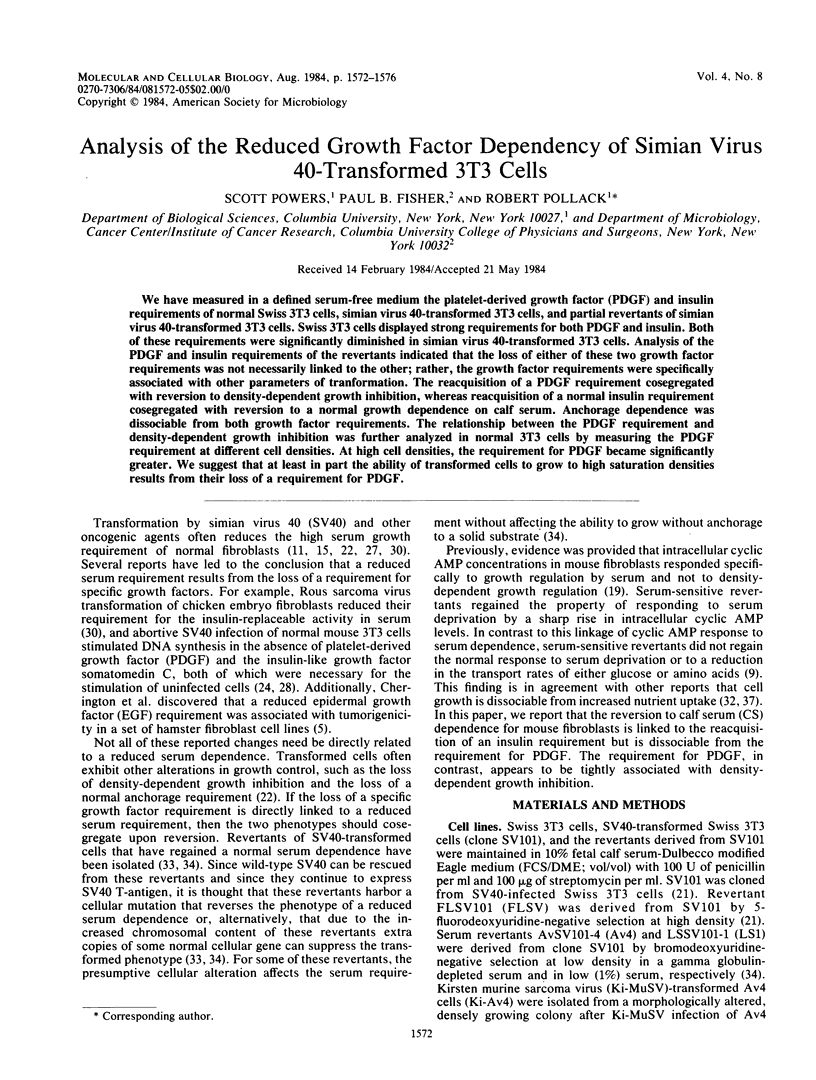
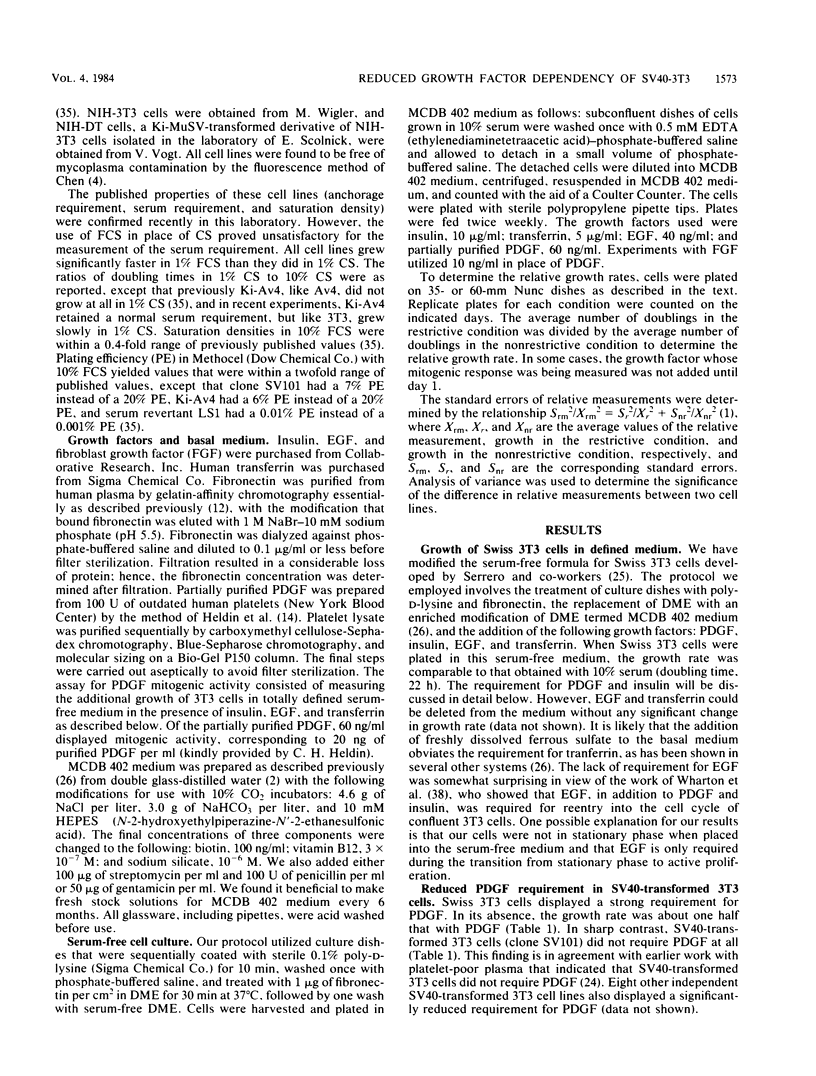
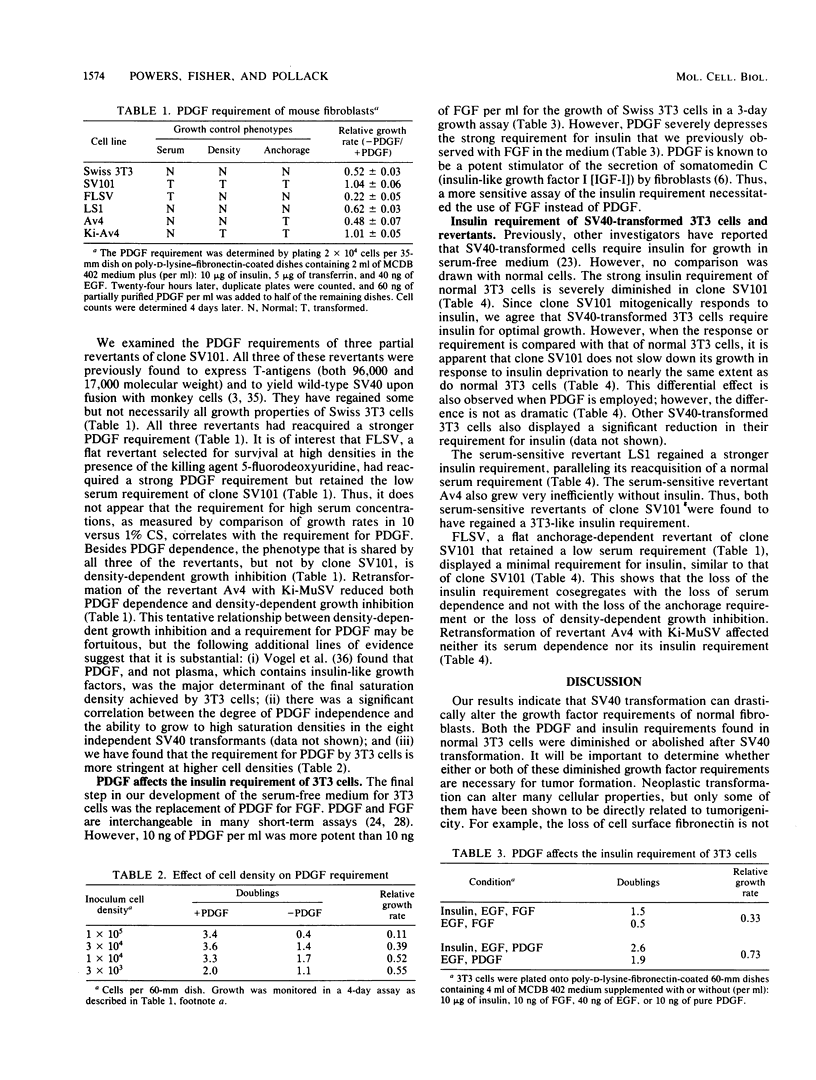
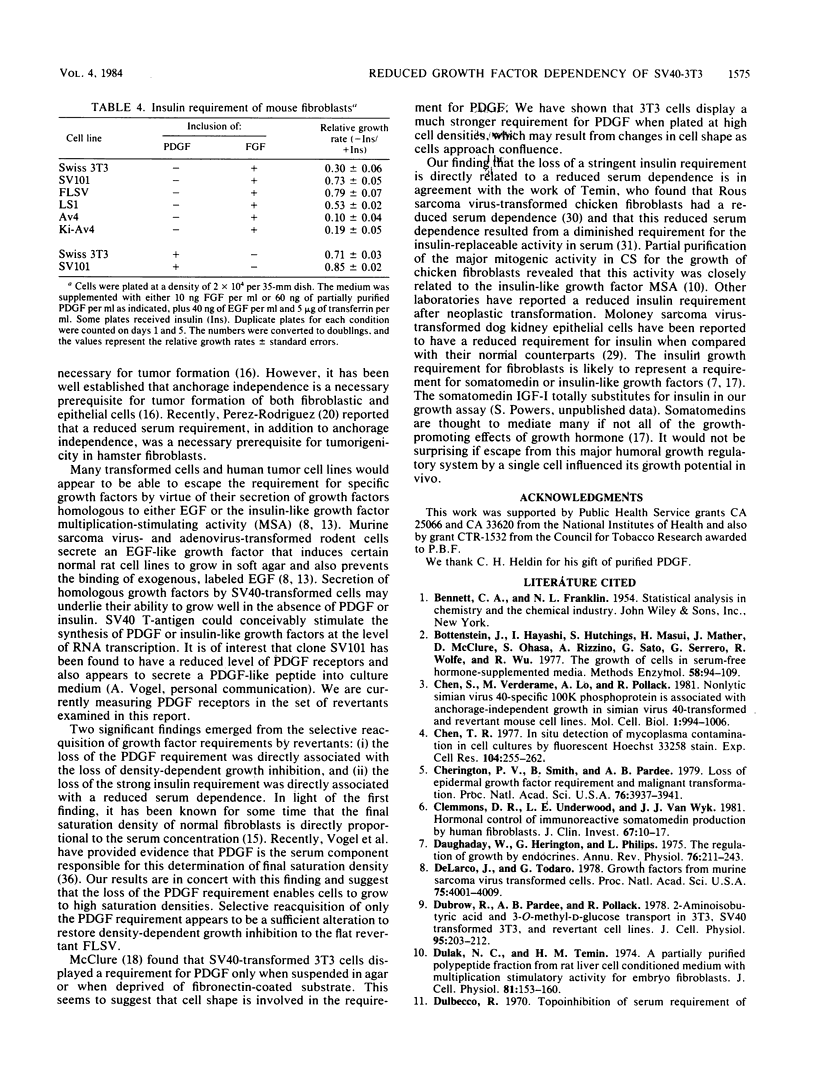
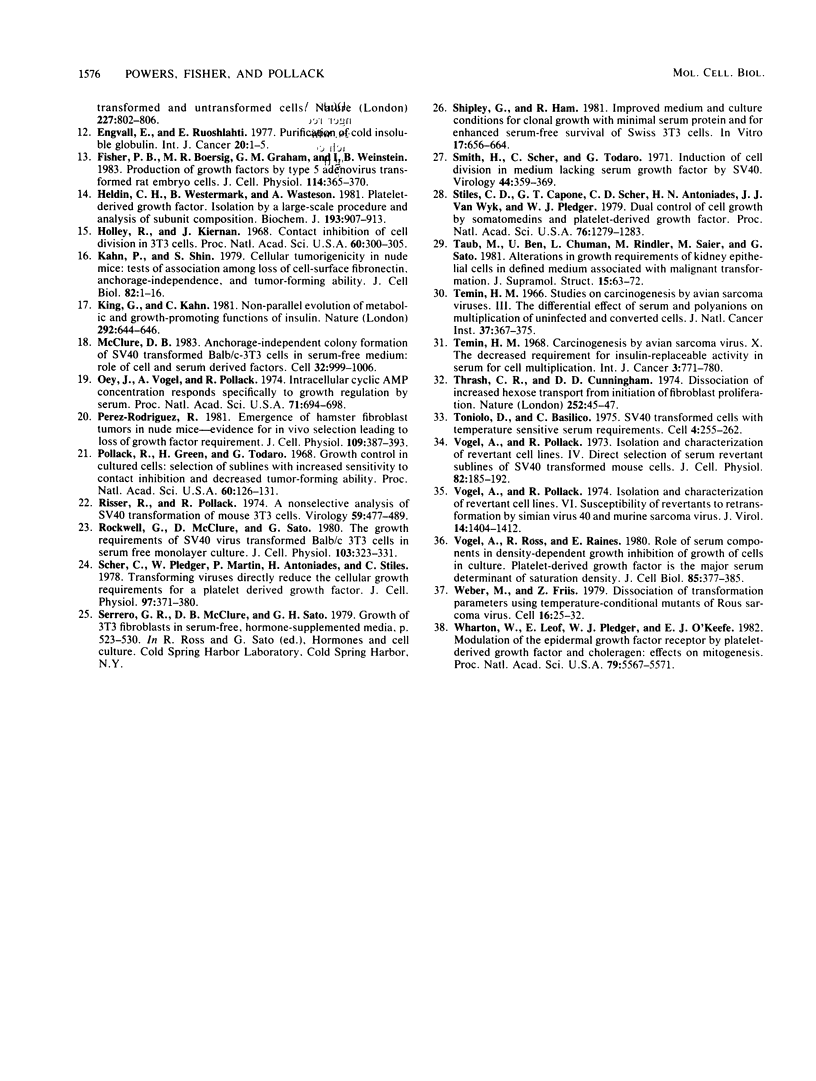
Selected References
These references are in PubMed. This may not be the complete list of references from this article.
- Bottenstein J., Hayashi I., Hutchings S., Masui H., Mather J., McClure D. B., Ohasa S., Rizzino A., Sato G., Serrero G. The growth of cells in serum-free hormone-supplemented media. Methods Enzymol. 1979;58:94–109. doi: 10.1016/s0076-6879(79)58127-0. [DOI] [PubMed] [Google Scholar]
- Chen S., Verderame M., Lo A., Pollack R. Nonlytic simian virus 40-specific 100K phosphoprotein is associated with anchorage-independent growth in simian virus 40-transformed and revertant mouse cell lines. Mol Cell Biol. 1981 Nov;1(11):994–1006. doi: 10.1128/mcb.1.11.994. [DOI] [PMC free article] [PubMed] [Google Scholar]
- Chen T. R. In situ detection of mycoplasma contamination in cell cultures by fluorescent Hoechst 33258 stain. Exp Cell Res. 1977 Feb;104(2):255–262. doi: 10.1016/0014-4827(77)90089-1. [DOI] [PubMed] [Google Scholar]
- Cherington P. V., Smith B. L., Pardee A. B. Loss of epidermal growth factor requirement and malignant transformation. Proc Natl Acad Sci U S A. 1979 Aug;76(8):3937–3941. doi: 10.1073/pnas.76.8.3937. [DOI] [PMC free article] [PubMed] [Google Scholar]
- Clemmons D. R., Underwood L. E., Van Wyk J. J. Hormonal control of immunoreactive somatomedin production by cultured human fibroblasts. J Clin Invest. 1981 Jan;67(1):10–19. doi: 10.1172/JCI110001. [DOI] [PMC free article] [PubMed] [Google Scholar]
- Daughaday W. H., Herington A. C., Phillips L. S. The regulation of growth by endocrines. Annu Rev Physiol. 1975;37:211–244. doi: 10.1146/annurev.ph.37.030175.001235. [DOI] [PubMed] [Google Scholar]
- Dubrow R., Pardee A. B., Pollack R. 2-amino-isobutyric acid and 3-O-methyl-D-glucose transport in 3T3, SV 40-transformed 3T3 and revertant cell lines. J Cell Physiol. 1978 May;95(2):203–211. doi: 10.1002/jcp.1040950210. [DOI] [PubMed] [Google Scholar]
- Dulak N. C., Temin H. M. A partially purified polypeptide fraction from rat liver cell conditioned medium with multiplication-stimulating activity for embryo fibroblasts. J Cell Physiol. 1973 Apr;81(2):153–160. doi: 10.1002/jcp.1040810204. [DOI] [PubMed] [Google Scholar]
- Fisher P. B., Boersig M. R., Graham G. M., Weinstein I. B. Production of growth factors by type 5 adenovirus transformed rat embryo cells. J Cell Physiol. 1983 Mar;114(3):365–370. doi: 10.1002/jcp.1041140315. [DOI] [PubMed] [Google Scholar]
- Heldin C. H., Westermark B., Wasteson A. Platelet-derived growth factor. Isolation by a large-scale procedure and analysis of subunit composition. Biochem J. 1981 Mar 1;193(3):907–913. doi: 10.1042/bj1930907. [DOI] [PMC free article] [PubMed] [Google Scholar]
- Holley R. W., Kiernan J. A. "Contact inhibition" of cell division in 3T3 cells. Proc Natl Acad Sci U S A. 1968 May;60(1):300–304. doi: 10.1073/pnas.60.1.300. [DOI] [PMC free article] [PubMed] [Google Scholar]
- Kahn P., Shin S. I. Cellular tumorigenicity in nude mice. Test of associations among loss of cell-surface fibronectin, anchorage independence, and tumor-forming ability. J Cell Biol. 1979 Jul;82(1):1–16. doi: 10.1083/jcb.82.1.1. [DOI] [PMC free article] [PubMed] [Google Scholar]
- King G. L., Kahn C. R. Non-parallel evolution of metabolic and growth-promoting functions of insulin. Nature. 1981 Aug 13;292(5824):644–646. doi: 10.1038/292644a0. [DOI] [PubMed] [Google Scholar]
- McClure D. B. Anchorage-independent colony formation of SV40 transformed BALB/c-3T3 cells in serum-free medium: role of cell- and serum-derived factors. Cell. 1983 Mar;32(3):999–1006. doi: 10.1016/0092-8674(83)90084-3. [DOI] [PubMed] [Google Scholar]
- Oey J., Vogel A., Pollack R. Intracellular cyclic AMP concentration responds specifically to growth regulation by serum. Proc Natl Acad Sci U S A. 1974 Mar;71(3):694–698. doi: 10.1073/pnas.71.3.694. [DOI] [PMC free article] [PubMed] [Google Scholar]
- Pollack R. E., Green H., Todaro G. J. Growth control in cultured cells: selection of sublines with increased sensitivity to contact inhibition and decreased tumor-producing ability. Proc Natl Acad Sci U S A. 1968 May;60(1):126–133. doi: 10.1073/pnas.60.1.126. [DOI] [PMC free article] [PubMed] [Google Scholar]
- Pérez-Rodriguez R., Chambard J. C., Van Obberghen-Schilling E., Franchi A., Pouysségur J. Emergence of hamster fibroblast tumors in nude mice--evidence for in vivo selection leading to loss of growth factor requirement. J Cell Physiol. 1981 Dec;109(3):387–396. doi: 10.1002/jcp.1041090303. [DOI] [PubMed] [Google Scholar]
- Risser R., Pollack R. A nonselective analysis of SV40 transformation of mouse 3T3 cells. Virology. 1974 Jun;59(2):477–489. doi: 10.1016/0042-6822(74)90457-7. [DOI] [PubMed] [Google Scholar]
- Rockwell G. A., Sato G. H., McClure D. B. The growth requirements of SV40 virus transformed Balb/c-3T3 cells in serum-free monolayer culture. J Cell Physiol. 1980 May;103(2):323–331. doi: 10.1002/jcp.1041030218. [DOI] [PubMed] [Google Scholar]
- Scher C. D., Pledger W. J., Martin P., Antoniades H., Stiles C. D. Transforming viruses directly reduce the cellular growth requirement for a platelet derived growth factor. J Cell Physiol. 1978 Dec;97(3 Pt 1):371–380. doi: 10.1002/jcp.1040970312. [DOI] [PubMed] [Google Scholar]
- Shipley G. D., Ham R. G. Improved medium and culture conditions for clonal growth with minimal serum protein and for enhanced serum-free survival of Swiss 3T3 cells. In Vitro. 1981 Aug;17(8):656–670. doi: 10.1007/BF02628401. [DOI] [PubMed] [Google Scholar]
- Smith H. S., Scher C. D., Todaro G. J. Induction of cell division in medium lacking serum growth factor by SV40. Virology. 1971 May;44(2):359–370. doi: 10.1016/0042-6822(71)90267-4. [DOI] [PubMed] [Google Scholar]
- Stiles C. D., Capone G. T., Scher C. D., Antoniades H. N., Van Wyk J. J., Pledger W. J. Dual control of cell growth by somatomedins and platelet-derived growth factor. Proc Natl Acad Sci U S A. 1979 Mar;76(3):1279–1283. doi: 10.1073/pnas.76.3.1279. [DOI] [PMC free article] [PubMed] [Google Scholar]
- Taub M., U B., Chuman L., Rindler M. J., Saier M. H., Jr, Sato G. Alterations in growth requirements of kidney epithelial cells in defined medium associated with malignant transformation. J Supramol Struct Cell Biochem. 1981;15(1):63–72. doi: 10.1002/jsscb.1981.380150107. [DOI] [PubMed] [Google Scholar]
- Temin H. M. Carcinogenesis by avian sarcoma viruses. X. The decreased requirement for insulin-replaceable activity in serum for cell multiplication. Int J Cancer. 1968 Nov 15;3(6):771–787. doi: 10.1002/ijc.2910030611. [DOI] [PubMed] [Google Scholar]
- Thrash C. R., Cunningham D. D. Dissociation of increased hexose transport from initiation of fibroblast proliferation. Nature. 1974 Nov 1;252(5478):45–47. doi: 10.1038/252045a0. [DOI] [PubMed] [Google Scholar]
- Toniolo D., Basilico C. SV40-transformed cells with temperature-dependent serum requirements. Cell. 1975 Mar;4(3):255–262. doi: 10.1016/0092-8674(75)90173-7. [DOI] [PubMed] [Google Scholar]
- Vogel A., Pollack R. Isolation and characterization of revertant cell lines. VI. Susceptibility of revertants to retransformation by simian virus 40 and murine sarcoma virus. J Virol. 1974 Dec;14(6):1404–1410. doi: 10.1128/jvi.14.6.1404-1410.1974. [DOI] [PMC free article] [PubMed] [Google Scholar]
- Vogel A., Ross R., Raines E. Role of serum components in density-dependent inhibition of growth of cells in culture. Platelet-derived growth factor is the major serum determinant of saturation density. J Cell Biol. 1980 May;85(2):377–385. doi: 10.1083/jcb.85.2.377. [DOI] [PMC free article] [PubMed] [Google Scholar]
- Weber M. J., Friis R. R. Dissociation of transformation parameters using temperature-conditional mutants of Rous sarcoma virus. Cell. 1979 Jan;16(1):25–32. doi: 10.1016/0092-8674(79)90184-3. [DOI] [PubMed] [Google Scholar]
- Wharton W., Leof E., Pledger W. J., O'Keefe E. J. Modulation of the epidermal growth factor receptor by platelet-derived growth factor and choleragen: effects on mitogenesis. Proc Natl Acad Sci U S A. 1982 Sep;79(18):5567–5571. doi: 10.1073/pnas.79.18.5567. [DOI] [PMC free article] [PubMed] [Google Scholar]
- de Larco J. E., Todaro G. J. Growth factors from murine sarcoma virus-transformed cells. Proc Natl Acad Sci U S A. 1978 Aug;75(8):4001–4005. doi: 10.1073/pnas.75.8.4001. [DOI] [PMC free article] [PubMed] [Google Scholar]


